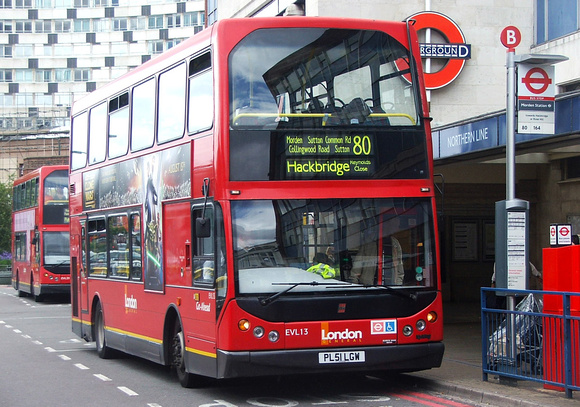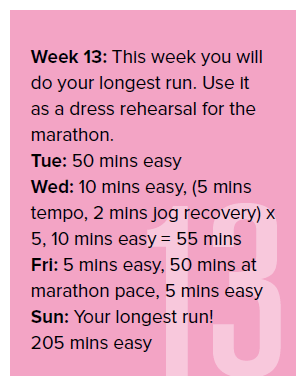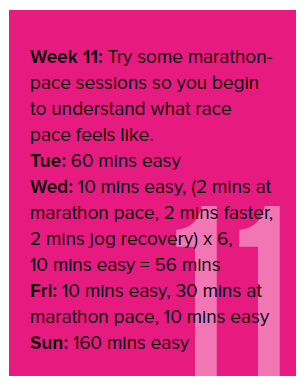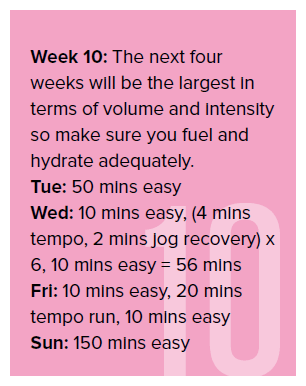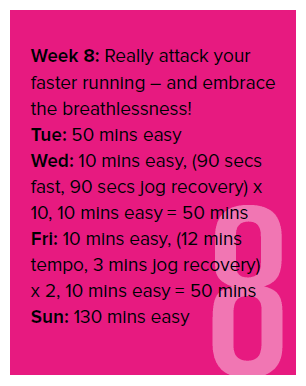transition
Generally, I do my long runs on a Thursday as this is the best fit around my family and work life. However, I had long planned week ten in my marathon training as the point at which I would transition my long runs from Thursdays to Sundays so that I could accustom myself to the routine of running at 9:15 on a Sunday morning as I shall on race day. I chose week ten because moving my long run back three days created the opportunity for a mini taper before Brighton Half Marathon which I raced on Sunday 26 February. (Actually replacing the scheduled long run this week).
So, with the flexibility of a 10 day ‘week’, I decided to mix things up a little whilst still retaining the core of my ongoing marathon training plan.
parkrun
Racing a parkrun for the first time this year, I returned to my home parkrun (Dulwich) for the 41st time. I set out with an approximate target of 19:30 in mind. Anticipating my run, I wasn’t sure whether I would be struggling to hold on for a sub 20 finish or if I might run something closer to 19:15. Off the start line I was pulled along with the typical exuberance of the front of a parkrun field such that at 500 metres I was I was at sub 19:15 pace. Knowing, and feeling, that this was unsustainable I checked my pace slightly and completed 4k averaging 19:45 pace. Dulwich parkrun is not quite flat, it is run over 3 laps of an oval loop which has a difference of 12 metres in elevation from one end to the other. One of the quirks of running 5k over these 3 laps is that kilometre four is always the slowest, being the most cumulatively uphill, and kilometre five is always the fastest, it being the most cumulatively downhill plus, of course, this is where you deploy your sprint finish! So, as I completed 4k and saw I was on track for 19:45, I knew I would record something significantly faster than that. This positive thought spurred me on and I was feeling good physically too. Pushing throughout the final kilometre and sprinting the final 250 metres, I finished in 19:28. Yay!
The first thing I did when I got home was plug this time into the race prediction calculator at Running For Fitness to gain an indication of what I might reasonably expect to run in Brighton. This produced an age graded prediction of 1:28:26. The second thing I did, for the next couple of days at least, was feel like I had been in a race! This was after all my first hard race effort of the year so far.
Doris …
Some easy running and a swim over the next few days helped me recover and I decided to do the tempo run specified in my marathon training plan as my last significant run before Brighton Half. This happened to fall on the day that Storm Doris passed over the UK which meant that my kilometre splits were all over the place starting, as I did, almost directly into the wind. With a target pace of 4:08/km, I opened with a 4:22 and a 4:26, including jumping over several, mercifully small, fallen branches. Blissfully I then turned and put the wind on my back for the remaining three kilometres which I completed in 4:13, 4:04 and 4:00. 4:13/km overall average and certainly tempo effort if not quite tempo pace!
I finished my pre-race build up the day before Brighton with a carb load stimulus session that I first used, in more approximate form, before Brighton Half, in 2014. I deliberately chose the direction of my mile pace and sprint efforts to avoid fighting Doris’s continuing high spirits and to harness the psychological boost of running quickly relatively effortlessly.
week 10 – ending Sunday 26 February
| day |
training |
|
| Fri |
— |
|
| Sat |
55 mins including 19:28 5k parkrun |
(4:31/km average) |
| Sun |
50 mins easy |
(5:01/km average) |
| Mon |
— |
(swim 1.2k, 32 mins) |
| Tue |
40 mins easy |
(4:59/km average) |
| Wed |
— |
|
| Thu |
15 mins easy (warm up)
21 mins tempo
5 mins easy (warm down) |
(5:06/km average)
(4:13/km average)
(4:58/km average) |
| Fri |
— |
|
| Sat |
14 mins easy (warm up)
2 mins 30 secs mile pace
30 secs sprint
9 mins easy (warm down) |
(4:49/km average)
(3:20/km average)
(<3:00/km average)
(5:05/km average) |
| Sun |
Brighton Half Marathon |
… |
[update March 2017, since my original post the race organiser has issued a statement confirming that the 2017, 2016 and 2015 races were all 146 metres short. The following race report remains as originally written before the statement was issued.]
Brighton Half
My regular long run partner Simon and I entered Brighton Half back in April 2016 so keen were we to make up for the disappointment of not running that year’s race. Brighton Half is fast, almost flat and with good weather, as I experienced in both 2014 and 2015, it is certainly a PB course. By the turn of the year running friends Ed and John had also signed up and we were in good spirits driving down to Brighton notwithstanding the weather.
Storm Doris was still venting her issues as we arrived in Brighton and this confirmed my reflections over the preceding few days. I modified my plan to combatting the conditions, seeking shelter in groups and primarily ensuring that I finished inside ninety minutes as a matter of pride! My secondary goal, to be considered during the race once the effect of the conditions became clear, was to run sub 88 minutes without going all out; to avoid the potential of compromising my marathon training.
One of the benefits of travelling with friends was that I inherited their good organisation and so I found my start pen – 1:20 to 1:29 – in good time. I positioned myself towards the rear and, as the start approached, decided I would hang back a little until the 1:30 pacer appeared. I stood aside as the gun went and then jogged up to the line so that the pacer caught me up as I crossed the line. I was probably being over cautious and certainly, I got a little bogged down in the first kilometre or two in the crowds. No matter, at least I was getting plenty of shelter from the wind.
Having run the race twice before I knew what to expect as we turned into the town, subsequently returned to the sea front and then headed East to the first turn around point. As I pivoted around the cone there, at approaching 7k race distance, Doris made her presence known. The South Westerly wind was significant and immediately I settled into my plan seeking strong runners and shelter wherever I could, whilst still pressing forward. Several times I began to press only to sense the increased wind effect, reconsider and resume a position of shelter. Running the core straight stretch of the route, 9k West, into the wind I soon felt confident that I would be able to finish within 90 minutes, probably within 89 and tried to carve out another whole minute. As the second turnaround approached the wind really began to take its toll and, frustratingly, I lost contact with a group I had been running with for most of the second half of the stretch. Running without cover the final two kilometres before the turnaround were significantly slower. Nonetheless, I contemplated the possibility that I might run a fast final 5k, with the wind, and lift my time back the right side of 89 minutes.
Frustratingly, having the wind on my back did not initially seem to have much effect. I completed the next kilometre in TBC. However, I then rallied for two or three kilometres before again hitting a difficult patch. I recall this as being caused by fatigue rather than the wind, but my perception may be flawed. Even so, I rallied once more and dug out a sub 4 minute final kilometre.
By the time I had had a post race massage and regrouped with my friends, for well-earned bacon sandwiches and coffee, we had all received our results by text and hence looked pretty pleased with ourselves in our post race photo 🙂
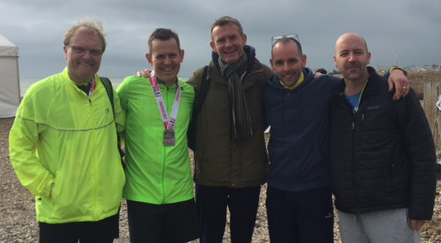
John, Chris, Ed, me and Simon looking pretty pleased with ourselves.
race data summary
| official finish time |
chip 87:58 |
| target |
88:00 – 0:02 inside |
| splits |
pace
TBC, TBC, TBC, TBC, TBC,
TBC, TBC, TBC, TBC, TBC,
TBC, TBC, TBC, TBC, TBC,
TBC, TBC, TBC, TBC, TBC,
TBC (final full km), TBC (final 97.5 metres)
approx HR
138, 148, 152, 153, 154,
153, 154, 155, 151, 153,
154, 155, 154, 155, 153,
151, 154, 155, 156, 156,
158 (final full km), 162 (final 97.5 metres) |
| biometric summary |
average HR – 153
max HR – 163 (estimated personal maximum – 172)
average cadence – 180
approx start weight – 71.0kg |
positions by chip time
(gun time) |
overall – 290 (318) out of 8049
gender – 273 (298) out of 4283
category VM50-59 – 21 (28) out of 581 |

